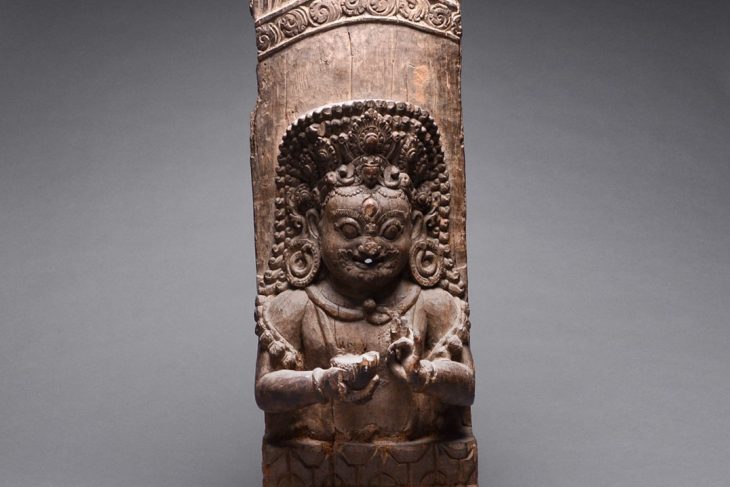Details
- Title : Nepalese Wooden Stele of Bhairava
- Year : 15 th Century AD to 16 th Century AD
- Classification : Sculpture
- Medium : Wood
- Dimension : 31.5″ (80.0cm) high
- Accession No : GNM_PF.5792_BAR_11
- Country/ Geo-location : Nepal
- Collection : BARAKAT MIRROR OF ALL AGES & CULTURES
- Status : Gallery Location : USA / Price available on request (as per Nov 2021)
- Footnotes : Bhairava (The Wrathful) is one of the more terrifying aspects of Shiva, the Hindu creator god. He is often depicted with frowning, angry eyes and sharp, tiger's teeth and flaming hair; stark naked except for garlands of skulls and a coiled snake about his neck. Often represented with multiple limbs, he most frequently carries a noose, trident, drum, and skull. Bhairava is Shiva at his most terrifying, at his most fearful. He may be understood as a particular manifestation, or emanation of Shiva, or as Shiva displaying himself at a very high level. In some myths, Shiva created Bhairava as an extension of himself, in order to chastise Brahma. Bhairava is the embodiment of fear, and it is said that those who meet him must confront the source of their own fears. His name describes the effect he has upon those who behold him, as it derives from the word “bhiru,” which means to become fearful – of feeling great fear. This wooden sculpture is a perfect representation of Bhairava. Intricately carved by a master sculptor, he has a fierce expression with three bulging round eyes. Stylized flames wrap around his head, also representing his fiery eyebrows and moustache. A hole has been pierced through his mouth in between his sharp fangs. His jewelry is composed of serpents: two coiled snakes represent his earrings while he wears a snake as a necklace. Perhaps even more intimidating is the diadem that crowns his head. A central head of a bodhisattva watches over from above, his peacefulness opposed to the series of skulls entwined with a snake. Represented from his torso up, he forms a mudra with one hand while holding either a drum or a decapitated skull in his other. Bhairava is a vision extracted from our worst nightmare; he plays with our fears and taunts our innermost weaknesses. However, even in his dread, he offers us hope, such as the hope for rebirth after the destruction of the world.


